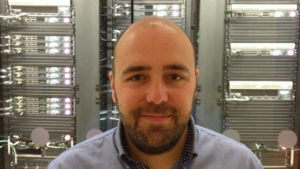(Image: Stockfresh)
| Software defined, real world | |
| “Development environments tend to be a wild-west for security with access open to all, however, in the world of SDN firewall rules can be implemented and tested dynamically as part of early unit testing and integration cycles” | 
Triangle Ross Wynne is technical architect consultant with Triangle |
|
From an operational perspective the activity of a network administrator can be a never-ending queue of tickets for new firewall requests, new VLANs, more network ports, VPN set-ups and, nowadays, setting up and maintaining a hybrid cloud network topology. These type of changes to an enterprise usually distracts a network administrator from proactive monitoring and maintenance of their core LAN and WAN. It can also introduce an element of human error in the misconfiguration of settings as well as configuration sprawl that never gets cleared up long after an application has been retired. Part of the solution can be the on boarding of the techniques learned in the large web-scale companies known as software defined networking. SDN can help in achieving high-pace, low impact, repeatable and consistent network changes to allow an IT organization to keep up with their developers in the never-ending quest to bring new features to market that can distinguish a company from their many competitors.If you have ever had to roll out an application late on a Thursday evening and found a firewall rule was missing in production, you’re not alone. Development environments tend to be a wild-west for security with access open to all, however, in the world of SDN firewall rules can be implemented and tested dynamically as part of early unit testing and integration cycles. The concept of a software defined network is not a new entry to the myriad of buzzword bingo terms of recent years. It is a real and solid IT solution that can be used by companies whether they be SMBs or large enterprises and will be a fact of life in the years to come. |
|
| Total control | |
| “The reality for most enterprises is that they already struggle with internal network resources and rarely achieve their goals in adopting a converged infrastructure” | 
Agile Networks Darragh Richardson, CEO |
|
Network infrastructure has resisted virtualisation more than any other part of the IT world. Whilst some SME firms have embraced the lower costs of shared infrastructure most enterprise firms are not willing to sacrifice the control and flexibility implied. And for the most part they are probably right.Many enterprises echo the words of Benjamin Franklin who famously said “the bitterness of poor quality remains long after the sweetness of low price is forgotten”. The savings made in adopting a standardised web-scale infrastructure don’t balance the compromises in deployment. If you are really, really large you can work through the minefield of network disaggregation with the internal skills and external buying power to deliver on savings without losing control. However, the reality for most enterprises is that they already struggle with internal network resources and rarely achieve their goals in adopting a converged infrastructure. Why? Consider the seemingly similar world of storage. Enterprises are now well used to the strategy of keeping some applications on legacy on-premises or private storage while migrating other apps to a cloud based options… no need for a big bang approach. Networking is different – most enterprises have large legacy investments and cannot hive off some of their network in isolation to trial a virtualised answer. The very interconnected nature of networking makes it harder to change and easier to stick with what has worked in the past. The truth is that for enterprises who are network dependent they simply don’t want to give away control to a third party. The network is very visible to end users and tolerance of failure is low. Most organisations have accumulated a legacy network which they cannot afford to replace in one big bang and would rather develop what they have. What they want is an integrator to help them sweat their existing assets and build a network which will evolve with their changing needs. Whilst it may be easy to spin up new storage for an unexpected project, it is a lot harder to magic up a new network in a similar fashion. In summary, the commercial advantages of a virtualised network have to be offset against the control you sacrifice. For many enterprises the network is too visible and too critical to outsource and they would rather stick with the devil they know than the devil they don’t. |
|
| Cyber-vices | |
| “To safely deploy an application, companies need to also address data security, identity, access control, policy and bring them into the SDN network. However, SDN alone is missing some key elements to safely deploy applications, because it focuses on the connectivity of device to device” | 
F5 Networks Gary Newe, director, systems engineering |
|
More devices, more cyber-vices. That’s the threat landscape pushing traditional IT models to their limits. Higher demands for faster deployment means conventional data centres are too static for today’s dynamic world – many of which were not designed to meet the demands of a today’s increasingly mobile workforce. Software defined networks (SDN) eliminates bottlenecks and deploys application services quickly. Through secure and automated solutions, companies can gain greater visibility into how users are experiencing applications on the network.Being fast and agile are essential attributes to manage the infrastructure efficiently. SDN is about making the network being more flexible and responsive, so that organisations are better positioned respond swiftly to challenges. To safely deploy an application, companies need to also address data security, identity, access control, policy and bring them into the SDN network. However, SDN alone is missing some key elements to safely deploy applications, because it focuses on the connectivity of device to device. Many leading companies have turned to F5 Networks, a leading provider of advanced application security solutions, to address these issues through software defined application services (SDAS) combined with SDN, which includes all the elements of application delivery and the higher level security identity. F5’s long-established technology offers an innovative ecosystem of integrated solutions that help application security and fluency within the network. This allows businesses to better understand the difference between a legitimate user genuinely accessing services or an attacker attempting to steal a company’s vital data. Looking forward, SDN and network virtualisation will automate the deployment of applications providing greater agility and reduce the network and costs, but deliver greater support for more applications. SDN enables enterprises to refocus their IT resources away from day-to-day infrastructure and move attention towards managing the quality of business experience. |
|







Subscribers 0
Fans 0
Followers 0
Followers